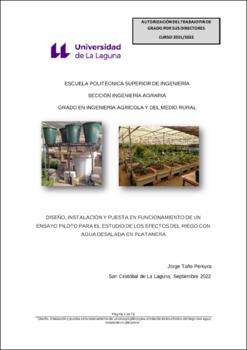Diseño, instalación y puesta en funcionamiento de un ensayo piloto para el estudio de los efectos del riego con agua desalada en platanera.
Autor
Taño Pereyra, JorgeFecha
2022Resumen
La escasez de agua y su calidad, sumada a los problemas de suelo y cultivo en Canarias, ha obligado a buscar nuevas alternativas para paliar la situación.
Debido a la sobre explotación de acuíferos y la falta de lluvias para la posterior
recarga de estos, unido a un aumento poblacional y una mayor extensión del
turismo han sido los principales causantes de esta escasez. Además, la
agricultura presenta sistemas de cultivos muchos más tecnificados y de
mayores superficies, demandando grandes cantidades de agua para solventar
las necesidades hídricas del cultivo.
Algunas de las soluciones, para una mejor gestión del agua, ha sido usar agua
depurada, aumentar el uso de sistemas de riego por localización y la más
importante, el agua desalada. Por ello, mi trabajo trata de estudiar los efectos
de este tipo de agua con otras de distintos orígenes sobre la planta y el suelo.
El ensayo se llevó a cabo en la Sección de Ingeniería Agraria, de la EPSI, de la
ULL y consistió en la utilización de cuatro tipos de aguas diferentes: agua
desalada con origen del canal ``Unión del norte´´, agua testigo sin desalar y
agua desalada con 4 tipos de tratamientos. La especie con la que se trabaja es
la Gruesa Palmera. La experiencia se llevó a cabo, en un invernadero tipo
Canario, en la zona alta se ubicaron los depósitos del agua y la planta de
ósmosis y en la zona continua por debajo 24 contenedores de 300L donde se
ubicará una planta por contenedor. Como sustratos, se usó un primer horizonte
más fino de picón y el resto tierra nueva extraída en los terrenos de la facultad
Al trabajar con 4 tipos de agua, corresponden 6 contenedores para cada
tratamiento. Debido a la presencia de aguacates en uno de los laterales y para
paliar el efecto de la sombra se ubicará la planta al azar. La ejecución de dicho
trabajo nos permitirá:
1º Conocer los efectos de las distintas aguas en el suelo y en la planta.
Página 5 de 76
``Diseño, instalación y puesta en funcionamiento de un ensayo piloto para el estudio de los efectos del riego con agua
desalada en platanera´´
2º Llevarlo a campo y recuperar la estructura de suelos afectados y por
ende aumentar las producciones y calidad.
3º Reducir los fertilizantes usados para paliar las consecuencias de las
malas aguas.
4º Controlar la incrustación o la corrosión en las redes de distribución del
agua.
A lo largo del desarrollo del ensayo se fueron tomando las medidas de
diferentes parámetros cuantitativos: la altura de la planta, el diámetro y la
longitud y ancho de cada hoja emitida.
`` The scarcity of water and its quality, added to soil and crop problems in the
Canary Islands, has forced the search for new alternatives to alleviate the
situation. Due to the overexploitation of aquifers and the lack of rain for their
subsequent recharge, together with a population increase and a greater
extension of tourism, they have been the main causes of this shortage. In
addition, agriculture presents much more technified crop systems and larger
areas, demanding large amounts of water to meet the water needs of the crop.
Some of the solutions for better water management have been to use purified
water, increase the use of localized irrigation systems and, most importantly,
desalinated water. For this reason, my work tries to study the effects of this type
of water with others of different origins on the plant and the soil.
The test was carried out in the Section of Agrarian Engineering, of the EPSI, of
the ULL and consisted of the use of four different types of water: desalinated
water originating from the ``Unión del Norte´´ channel, control water without
desalination and desalinated water with 2 types of treatments. The species with
which we work is the Thick Palm Tree. The experience was carried out in a
Canary-type greenhouse, in the upper area the water tanks and the osmosis
plant were located and in the continuous area below, 24 300L containers where
one plant per container will be located. As substrates, a first thinner layer of
picón was used and the rest was new earth extracted on the grounds of the
faculty.
When working with 4 types of water, there are 6 containers for each treatment.
Due to the presence of avocados on one of the sides and to alleviate the effect
of the shade, the plant will be located randomly. The execution of this work will
allow us to:
1º Know the effects of the different waters on the soil and on the plant.
2º Take it to the field and recover the structure of affected soils and therefore
increase production and quality.
3º Reduce the fertilizers used to alleviate the consequences of bad water.
4º Control scale or corrosion in the water distribution networks.
Throughout the development of the test, the measurements of different
quantitative parameters were taken: the height of the plant, the diameter and
the length and width of each leaf emitted.





